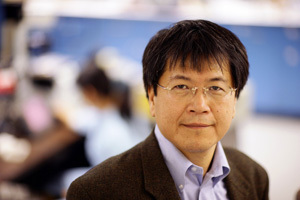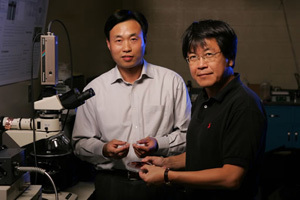
The behavior of fluids seems simple and intuitive—rivers flow downhill, drinks take the shape of the glass they’re in, etc.
But at extremely small scales, fluids follow a physics that can seem strange to us. The effects of gravity and inertia, for example, give way to more powerful forces like surface tension and viscosity. By understanding and exploiting these properties, engineers in the young field of “microfluidics” have developed a wide range of useful applications, including well-known ones in the home (inkjet printers) and on police dramas (DNA analyzers).
For Hsueh-Chia Chang, Bayer Professor of Chemical and Biomolecular Engineering at the University of Notre Dame, the greatest uses of microfluidic technology still lie ahead, in applications that will help tackle some of the world’s toughest health and environmental problems.
Chang’s vision is of easy-to-operate, handheld devices that can rapidly detect such things as pathogens in blood, toxins in food and water, and even track invasive species as they threaten crops and ecosystems. It is a vision in which the power of a modern research lab is concentrated into a smartphone-sized tool that can be used to diagnose disease as easily in a remote village as it can in a city hospital.
And it is a vision informed by a life journey that stretches from Southeast Asia to South Bend.
“I have seen third world poverty firsthand,” says Chang. “I have also seen what malaria can do, as well as polio. Typhoid, TB and even cholera were always part of life. After I established myself academically, I decided I should do something that can impact human society. Rapid point-of-care diagnostics for the developing world happened to be something I can contribute to and I seized the opportunity.”Chang was born in Taiwan, but moved several times as the family followed the career path of his father, a biochemist.
“Upon arriving in Singapore,” recounts Chang, “we found that our new home was without electricity or running water. We were relatively well off and I do not remember life being particularly hard, but we had an outhouse in the yard. Bathing for me was going to the water pump in the yard and dousing myself there. Nights were spent listening to a transistor radio around a kerosene lamp, and going to school meant squeezing into a taxi with about 10 other kids. This lasted 3 years until we went to Malaysia.”
Chang started high school in Kuala Lumpur, but as a Chinese foreigner he was prevented by Malaysian policies at the time from becoming a citizen or attending college.
His prospects changed when he met Sam and Dodo Standring, math and science teachers from California. They were amazed by the young man’s sense of humor, athletic ability, and intelligence, particularly his facility with chemistry. By promising to serve as his guardians they convinced Chang’s parents to let him come back to the U.S. for his senior year of high school.
As a student (and new English speaker) at Troy High School in Fullerton, Calif., Chang won a number of academic awards. In one case, he collaborated with a Cal State professor on a project that highlighted his math abilities, and this brought him to the attention of the California Institute of Technology. Caltech offered him a work-study scholarship, and he supported himself by working 10 to 20 hours a week as both a computer programmer and food service employee, and by handling odd jobs.
Despite these challenges, Dodo Standring says that it was his work ethic, instilled in him by his mother, that enabled Chang to graduate from Caltech and earn a Ph.D at Princeton by the time he was 24.
After several teaching stints around the U.S., Chang and his wife, Mei-Chi Shaw, a professor of mathematics, both found a home at Notre Dame.
Here, he expanded his research, served as chair of the department, developed several patents on microfluidic processes, wrote a definitive textbook on the field, started a leading journal, and founded the Center for Microfluidics and Medical Diagnostics.
One of the overarching goals throughout his career has been to forge multidisciplinary collaborations focused on the biomedical applications of microfluidics.
He explains, “My scientific contribution is from the transport angle—how to concentrate and sort molecules and detect them on small devices. These are engineering challenges involving a lot of transport and flow physics, which I specialize in. They are also the key scientific issues in designing biosensors and diagnostics for in-field applications.”
More recently, Chang has become a principal investigator in Notre Dame’s new Advanced Diagnostics and Therapeutics (AD&T) initiative, which is a broader program, spanning both science and engineering, to develop powerful and portable technologies for medical and environmental health.

“Chia Chang’s research goals are a great example of what Advanced Diagnostics and Therapeutics is all about” says Paul Bohn, Arthur J. Schmitt Professor of Chemical and Biomolecular Engineering and director of the initiative. “Our purpose is to take discoveries in the lab that have great potential and, with partners from inside and outside of the University, test them, turn them into usable tools, and get those tools out into the world where they can do some real good. It’s very entrepreneurial.”
Chang adds, “The entrepreneurial spirit of AD&T is very attractive to me, as is the fact that outside companies are starting to license and develop my technologies. In this regard, the proximity of Notre Dame’s Innovation Park is also important.”
As one of the University’s recent Strategic Research Investments, AD&T is part of Notre Dame’s commitment to serving society as a preeminent research university, and that is also part of the appeal to Chang.
“We still have a lot of growing to do, particularly in research,” he says, “and I feel I can contribute to this and make a bigger impact [at Notre Dame] than at other places.”
Though he’s mindful of where he’s come from, it is this focus on the future that continues to excite Chang. “My goal is that more diagnostic technologies, from my lab and others, be developed—technologies that can make a lasting impact on global health.”